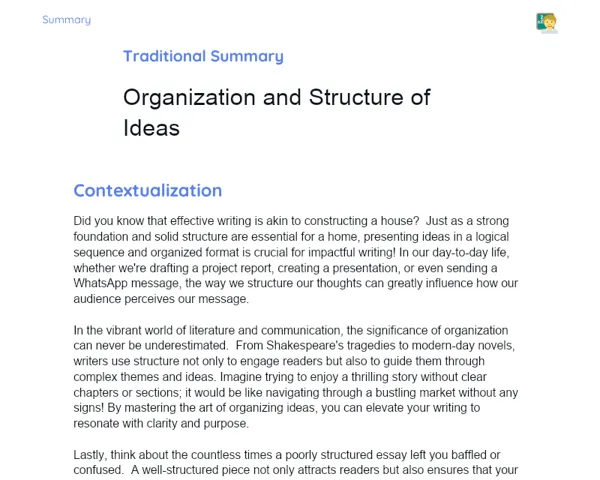Socioemotional Summary Conclusion
Goals
1. Learn how comparatives and superlatives are formed along with their distinctive characteristics.
2. Identify comparative and superlative forms within sentences.
3. Enhance socio-emotional skills such as self-awareness and responsible decision-making.
Contextualization
Have you ever paused to think about how language can completely change our way of expressing ourselves? Imagine being able to say in English that something is 'more interesting' or 'less pleasant'! Mastering the use of comparatives and superlatives not only improves your language skills but also helps in making better choices and expressing your thoughts more clearly. Let’s begin this learning journey together!
Exercising Your Knowledge
Understanding Comparatives and Superlatives
Comparative and superlative forms are important tools in English that enable us to compare and emphasize qualities of people, objects, or situations. They are very useful when it comes to expressing opinions and emotions with clarity.
-
Comparatives are used to compare two things. For example, 'Tom is taller than Jerry.'
-
Superlatives are used to highlight a quality within a group. For example, 'Tom is the tallest in the class.'
-
These forms help us articulate preferences and opinions, thus making our communication more precise.
How to Form Comparatives
Although forming comparatives might seem challenging initially, a few simple rules make it quite straightforward. For short adjectives, we add the '-er' ending, whereas for longer adjectives, we use 'more' before the word.
-
For short adjectives: Attach '-er' at the end (e.g., 'big' becomes 'bigger').
-
For longer adjectives: Use 'more' prior to the adjective (e.g., 'beautiful' becomes 'more beautiful').
-
Following these guidelines ensures clear and effective comparisons.
How to Form Superlatives
Similarly, superlative forms adhere to specific rules. For short adjectives, the '-est' ending is added, while longer adjectives use 'most' before the adjective.
-
For short adjectives: Add '-est' at the end (e.g., 'big' becomes 'biggest').
-
For longer adjectives: Precede the adjective with 'most' (e.g., 'beautiful' becomes 'most beautiful').
-
Understanding these rules is crucial for emphasizing attributes and aids in decision-making.
Key Terms
-
Comparative: An adjective form used to compare two things.
-
Superlative: An adjective form used to stress a characteristic within a group.
-
Adjective: A word that describes or gives more information about a noun.
For Reflection
-
How can the use of comparatives and superlatives enhance your everyday communication?
-
In what ways might the skills learnt from this lesson boost your confidence when speaking English?
-
Think of a situation where using comparatives and superlatives could improve the clarity of your message. How might that change your understanding or that of others?
Important Conclusions
-
We explored the differences between comparatives and superlatives, which are essential for clear communication in English.
-
We learned to form comparatives by adding '-er' for short adjectives and using 'more' for longer adjectives.
-
We understood that superlatives are formed by adding '-est' for short adjectives and using 'most' for longer adjectives.
-
We discussed how proper usage of these forms can lead to more informed decision-making and better self-expression.
Impacts on Society
Comparatives and superlatives are extremely useful in everyday scenarios. For instance, when deciding which product to buy, being able to compare options and choose the 'best' or 'cheapest' item is invaluable. These skills not only boost communication but also assist in making smarter choices.
Additionally, knowing how to use these forms effectively can enhance your confidence in public speaking. Think of describing your holiday as being 'more exciting' than the previous one; it not only makes your narrative clearer but also helps convey your emotions more accurately, allowing others to better understand your sentiments.
Dealing with Emotions
To help manage your emotions while learning about comparatives and superlatives, consider an exercise based on the RULER method. Start by recognising how you feel about the topic—whether it’s anxiety, curiosity, or even excitement. Reflect on what might be triggering these emotions, be it the complexity of the rules or the joy of learning something new. Identify these feelings and decide on the best way to express them. Finally, practice managing your emotions: if you're anxious, try a few deep breathing exercises; if you're excited, use that energy to focus on your studies. This should help in building self-awareness and emotional balance during your learning sessions.
Study Tips
-
Practice creating sentences with comparatives and superlatives daily using scenarios from your daily life.
-
Engage in listening exercises by tuning into English conversations, movies, or shows to observe real-life usage.
-
Work in groups with peers to construct and review sentences together—it’s a great way to clear doubts and share learning experiences.


